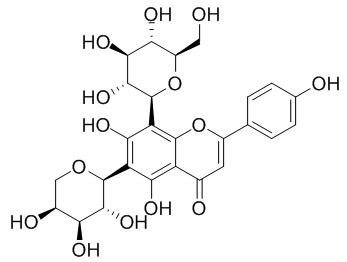Isoschaftoside
Isoschaftoside is used as an intercrop due to its allelopathic inhibition of parasitism by Striga hermonthica, an obligate parasitic weed that can devastate the maize crop. Isoschaftoside has anti-tumor, antioxidant, and antimicrobial activities, it also possesses strong nematicidal activity against M. incognita.
Inquire / Order:
manager@chemfaces.com
Technical Inquiries:
service@chemfaces.com
Tel:
+86-27-84237783
Fax:
+86-27-84254680
Address:
1 Building, No. 83, CheCheng Rd., Wuhan Economic and Technological Development Zone, Wuhan, Hubei 430056, PRC
Providing storage is as stated on the product vial and the vial is kept tightly sealed, the product can be stored for up to
24 months(2-8C).
Wherever possible, you should prepare and use solutions on the same day. However, if you need to make up stock solutions in advance, we recommend that you store the solution as aliquots in tightly sealed vials at -20C. Generally, these will be useable for up to two weeks. Before use, and prior to opening the vial we recommend that you allow your product to equilibrate to room temperature for at least 1 hour.
Need more advice on solubility, usage and handling? Please email to: service@chemfaces.com
The packaging of the product may have turned upside down during transportation, resulting in the natural compounds adhering to the neck or cap of the vial. take the vial out of its packaging and gently shake to let the compounds fall to the bottom of the vial. for liquid products, centrifuge at 200-500 RPM to gather the liquid at the bottom of the vial. try to avoid loss or contamination during handling.
Food Research2022, 6(6): 30-38.
JMicrobiol Biotech Food Sci2021, e4289.
Int J Mol Sci.2022, 23(21):13112.
Chem Biol Interact.2016, 260:168-175
Int J Mol Sci.2024, 25(15):8101.
Molecules.2022, 27(22):7997.
Food Structure2023, 36:100324.
ACS Synth Biol.2022, doi: 10.1021.
LWT2020, 130:109535
Trop J Nat Prod Res2023, 7(12):5611-5615.
Related and Featured Products
Phytochemistry, 2010, 71(8-9):904-908.
Isoschaftoside, a C-glycosylflavonoid from Desmodium uncinatum root exudate, is an allelochemical against the development of Striga.[Reference:
WebLink]
METHODS AND RESULTS:
In East African small-holder farming of maize, the cattle forage legume, Desmodium uncinatum is used as an intercrop due to its allelopathic inhibition of parasitism by Striga hermonthica, an obligate parasitic weed that can devastate the maize crop. Bioassay-guided fractionation of the root extract of D. uncinatum revealed Isoschaftoside to be the main compound in the most potent fraction inhibiting growth of germinated S. hermonthica radicles.
Bioassays repeated with Isoschaftoside isolated from a different plant source, Passiflora incarnata, proved it to be a biologically active component.
CONCLUSIONS:
Analysis of the root exudates produced by hydroponically grown D. uncinatum showed Isoschaftoside to be present in the hydroponic media at biologically active concentrations of 10–100 nM.
European Food Research and Technology, 2006, 223(1):102-109.
Phenol content related to antioxidant and antimicrobial activities of Passiflora spp. extracts.[Reference:
WebLink]
METHODS AND RESULTS:
Methanolic extracts were prepared from different organs of plants from five Passiflora species obtained by zygotic embryo culture and evaluated for their capacity to quench DPPH and ABTS•+ radicals in comparison to that of Trolox, a water soluble vitamin-E analogue. Moreover their antimicrobial activity against E. coli was tested by agar diffusion and turbidity assays. P. nitida, P. foetida, and P. palmeri showed antimicrobial activity. P. nitida and P. palmeri also showed high antioxidant activity. P. tenuifila and P. coriacea demonstrated antioxidant power but not antimicrobial activity. The phenolic content of the different extracts was studied and quantified by spectrophotometric methods, HPLC, and mass spectrometry.
CONCLUSIONS:
High antioxidant activity correlated with high amounts of o-diphenol and catechin. An unknown component, tentatively identified as structural isomer of Isoschaftoside, appeared to correlate with antimicrobial activity.
Molecules, 2011, 16(6):5079-5086.
Nematocidal Flavone-C-Glycosides against the Root-Knot Nematode (Meloidogyne incognita) from Arisaema erubescens Tubers.[Reference:
WebLink]
METHODS AND RESULTS:
A screening of several Chinese medicinal herbs for nematicidal properties showed that Arisaema erubescens (Wall.) Schott tubers possessed significant nematicidal activity against the root-knot nematode (Meloidogyne incognita). From the ethanol extract, two nematicidal flavone-C-glycosides were isolated by bioassay-guided fractionation.The compounds were identified as schaftoside and Isoschaftoside on the basis of their phytochemical and spectral data.
CONCLUSIONS:
Schaftoside and Isoschaftoside possessed strong nematicidal activity against M. incognita (LC(50) = 114.66 μg/mL and 323.09 μg/mL, respectively) while the crude extract of A. erubescens exhibited nematicidal activity against the root-knot nematode with a LC(50) value of 258.11 μg/mL.
World Journal of Traditional Chinese Medicine (English), 2018.
Network Pharmacology-based Study of the Active Constituents of Chinese Medicinal Formulae for Antitumor Mechanism.[Reference:
WebLink]
To investigate the network pharmacology of anti-tumor Chinese medicinal formulae and explain the synergistic mechanism of various active ingredients of Chinese medicinal formulae.
METHODS AND RESULTS:
We collected the anti-tumor Chinese medicinal formulae and chose several single herbs with the top frequency for further study. The chemical constituents of these herbs were downloaded from databases CNPC and Traditional Chinese Medicine Systems Pharmacology and were analyzed to set up the anti-tumor material basis. The genes regulated by these constituents were retrieved in Traditional Chinese Medicine integrated database and Comparative Toxicogenomics database. We collected 65 anti-tumor Chinese medicinal formulae, and 4 single herbs were selected, including Licorice, Radix astragali, Panax ginseng, and Radix scutellariae, which consist of 172, 70, 293, and 92 known constituents, respectively. The constituent–gene network, protein–protein interaction network, gene–pathway enrichment network, and gene–disease network were constructed. Moreover, molecular docking was employed to clarify the interactions between active constituents and key drug targets (PTG2, epidermal growth factor receptor, peroxisome proliferator-activated receptor gamma, estrogen receptor 1, mammalian target of rapamycin, AKT1, mitogen-activated protein kinase 1 [MAPK1], peroxisome proliferator-activated receptor alpha, and MAPK8). Most of the constituents could act on multiple targets, whose structures mainly belong to alkaloids, flavonoids, and their glycosides, organic acids, or dianthrone, and their representative chemical constituents include narcissus glycosides, rutin, dauricine, scutellarin, baicalin, Isoschaftoside, and leucovorin.
CONCLUSIONS:
The network mechanism of the effective constituents from traditional Chinese medicines (TCMs) for anti-tumor therapy was partially uncovered by using statistical methods, network pharmacology methods, and molecular docking methods. This study will provide important information for new drug design with multiple targets for anti-tumor therap.



